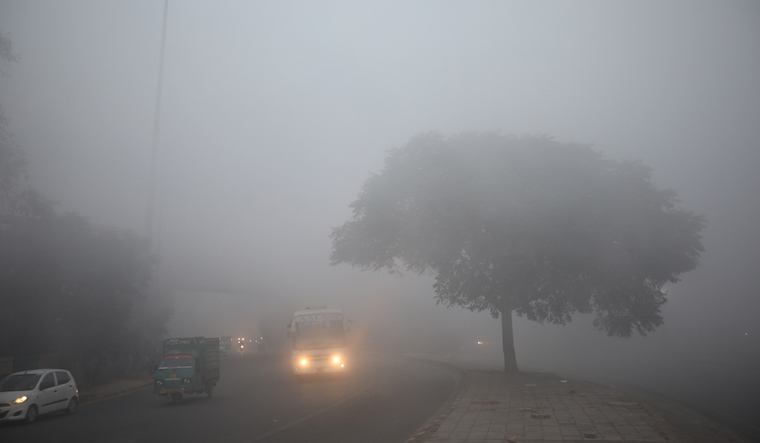Swachh Vayu Survekshan And The Search For Clean Air
Sep 10, 2023 | Pratirodh Bureau
To make Swachh Vayu Survekshan (SVS) a success, proper representation of every component of the assessment framework is required. Since the major goal of NCAP is to reduce PM10 and PM2.5, both pollutants should be given more weightage in the SVS. Currently, only PM10 has been given weightage, and that too a mere 2.5% (Image: PTI)
Every year during the winter season, air quality across India deteriorates to hazardous levels. The combination of low temperatures and still conditions keep pollutants trapped in the atmosphere, further exacerbating the issue. Interestingly, neither coastal nor some of our cleanest cities are strangers to this phenomenon. For instance, Mumbai saw several poor air quality days last year, with the Air Quality Index (AQI) touching upwards of 300. Even cities like Indore, Surat and Navi Mumbai, ranked as India’s top three cleanest cities under the Swachh Bharat Mission (SBM), are considered non-attainment cities – i.e. cities whose air quality exceeds the permissible particulate matter (PM) prescribed by the National Ambient Air Quality Standards (NAAQS) between 2011 to 2015 under the National Clean Air Programme (NCAP).
In 2016, the Swachh Bharat Mission was started by the Ministry of Housing and Urban Affairs (MoHUA) to increase cleanliness in cities. In 2020, the mission added two major components of air pollution to the mix: dust from roads and construction sites and emissions from municipal solid waste management. In May 2022, the Ministry of Environment, Forest and Climate Change (MoEFCC) started the ‘Swachh Vayu Survekshan,’ a survey that includes all major sources of air pollution that were not represented in the Swachh Bharat Mission such as emissions from industries, household cooking, transportation, brick kilns, etc. The key objective of the Swachh Vayu Survekshan is to rank 131 non-attainment cities based on their air quality and implementation of their city’s clean air action plan as identified under the NCAP.
What the Swachh Vayu Survekshan Gets Right
The Swachh Vayu Survekshan (SVS) assessment framework assigns specific percentages to all the identified sectors contributing to air pollution. The control measures for each sector are divided into critical components for easier management. For example, municipal solid waste (MSW) burning is categorized into six parts – waste generation, waste collection, processing, legacy waste handling, ban on municipal waste burning and plastic waste collection. SVS also takes into account electric vehicle (EV) infrastructure, which will encourage state and urban local bodies to promote EV uptake through incentives. Furthermore, the extra weightage given to the coverage of Liquified Petroleum Gas (LPG)/Piped Natural Gas (PNG), door-to-door waste collection and round-the-clock electricity supply in the smaller cities (population of 3 lakh to 10 lakh) benefits both local businesses and local innovation. It also highlights the need for integrating much-needed infrastructure.
What Is Currently Missing From the Swachh Vayu Survekshan
While these measures are indeed laudable, strict implementation remains a challenge. For instance, SVS assigns marks for municipal solid waste collection (MSW), processing and disposal but does not include the ‘implementation’ of these control measures. Collection, disposal, processing and banning of waste burning do not automatically ensure that waste burning will not occur. This was observed, under the Surat Clean Air Action Plan (SCAP), by WRI India. While Surat city’s MSW collection is pegged at nearly 100%, MSW burning incidents were nonetheless observed – possibly due to behavioural reasons.
In the road dust sector, urban forest cover has been neglected. Trees and vegetation absorb dust and pollutants – this forms a key action point of the NCAP. Similarly, two measures for combating construction dust – recycling construction and demolition (C&D) waste and using locally sourced material – are completely absent from the construction and demolition sector. Lastly, greater focus is needed on public transport instead of just Pollution Under Control (PUC) measures. Encouraging public transport will help decarbonize the transport sector while ensuring efficient and equitable transport infrastructure for all.
Importance of Community Participation
The power of public participation and the need to convey critical information cannot be undermined in this endeavor. More importance should be given to citizen participation through public grievances redressal systems and raising public awareness through information, education and communication (IEC) activities as highlighted in the NCAP. The remarkable efforts of the Swachh Bharat Mission are visible through their vibrant awareness campaigns, regular cleanliness drives, Safaimitra volunteers and the people-first focused toolkits. The Swachh Vayu Survekshan should also undertake such initiatives to lend impetus to effective air quality and waste management.
The Way Forward
To make Swachh Vayu Survekshan (SVS) a success, proper representation of every component of the assessment framework is required. Since the major goal of NCAP is to reduce PM10 and PM2.5, both pollutants should be given more weightage in the SVS. Currently, only PM10 has been given weightage, and that too a mere 2.5%. In the future, the SVS must consider a regional approach since air pollution is a transboundary issue. This ‘airshed’ approach should include adjacent rural areas and towns with a population of less than 1 lakh, as air pollution is not just confined to major cities.
Swachh Bharat Mission revises its toolkit every year as per the previous year’s outcomes and modifies its approach annually to meet set targets. A staggered approach like this, which started with 73 cities (2016) and expanded to 4,354 cities (2022), could be followed, albeit with accelerated timelines. The SVS is a non-statutory document and hence requires collaborative efforts. Bringing together innovators, citizens and government authorities onto a common platform for collective action is key to making our cities breathe easy.
(Published under Creative Commons from WRI-India. Read the original article here)
